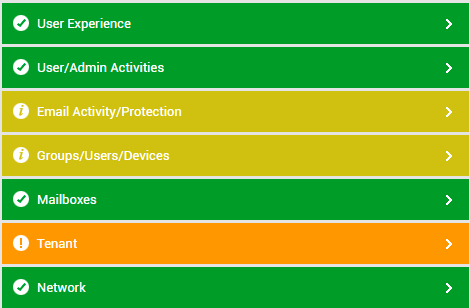Monitoring Microsoft Exchange Online
To monitor the managed Microsoft Exchange Online component, login to the eG management console as a user with monitoring privileges.
Browse the Components At-A-Glance section of the Monitor Home page that appears, and locate the Microsoft Exchange Online component type. Click on the bar that corresponds to this component type. This will lead you to the Layers tab page, where you can view the monitoring model for Microsoft Exchange Online (see Figure 5).

Figure 5 : Layer model for the Microsoft Exchange Online component
Each layer of Figure 5 is mapped to tests that report on a wide variety of KPIs such as availability, mailbox usage, email activity, mailbox protection, and user activities of Exchange Online. Using these metrics, administrators can find quick and accurate answers to the following performance queries:
- Is Exchange Online available over the network? If so, how quickly is it responding to network requests?
- Is Exchange Online available for sending/receiving mails? If so, how quickly is Exchange Online able to send/receive mails?
- Were any email delivery failures captured? Which emails could not be delivered?
- Are too many messages pending delivery? Which mails are still to be delivered?
- Has any sudden and significant increase been noticed in the number and size of incoming mails? If so, which user has received the maximum number of mails? Which user has received mails of large sizes?
- Has any sudden and significant increase been noticed in the number and size of outgoing mails? If so, which user has sent the maximum number of mails? Which user has sent mails of large sizes?
- Is MAPI connectivity available to user mailboxes available? If so, then how long does the MAPI connection typically take? Has any latency been noticed in MAPI connections?
- Is the total size of mailboxes on Exchange Online growing abnormally? If so, which mailboxes are contributing to this growth?
- Has any mailbox's size reached the 'Prohibit send/receive' limit? If so, which one?
- Were any mailboxes soft-deleted recently? If so, which ones?
- Which mailboxes have been enabled for forwarding mails to external users?
- Which datacenter has the maximum number of mailboxes? From which geography do most mailbox users come?
- Were any DLP rules violated? If so, which rules were violated? Which DLP policy includes such rules? Which emails that violated the rules?
- Was any malware captured in incoming/outgoing mails?
- Who are the top receivers and senders of malware, in terms of the number of malware-infected mails sent/received and the malware size?
- Are too many spam mails being received/sent? Who are the top senders/receivers of spam mails, in terms of the number of spam mails sent/received and the size of spam mails?
- Do any emails match a transport rule? If so, which ones?
- Are there any users whose password is about to expire? If so, who are they?
- Who are the most inactive users of Exchange Online?
- Did any Exchange Online administrator make any configuration changes to Exchange Online recently? If so, who made what change when?
- Were any configuration changes made by mailbox owners? If so, who made what change when?
This
The Groups/Users/Devices Layer
The Email Activity/Protection Layer
